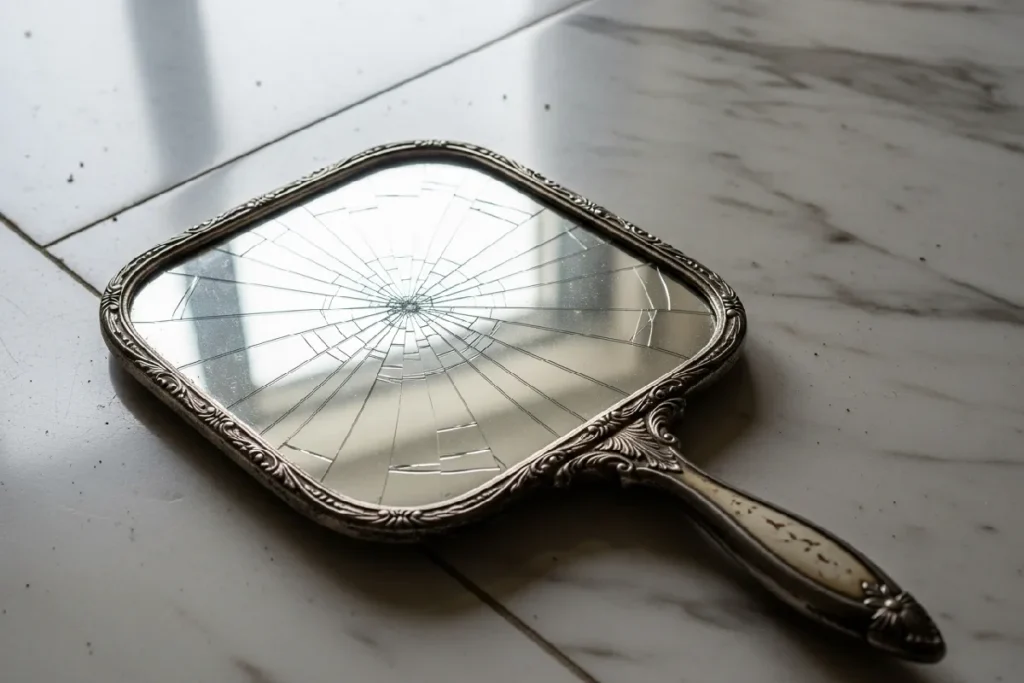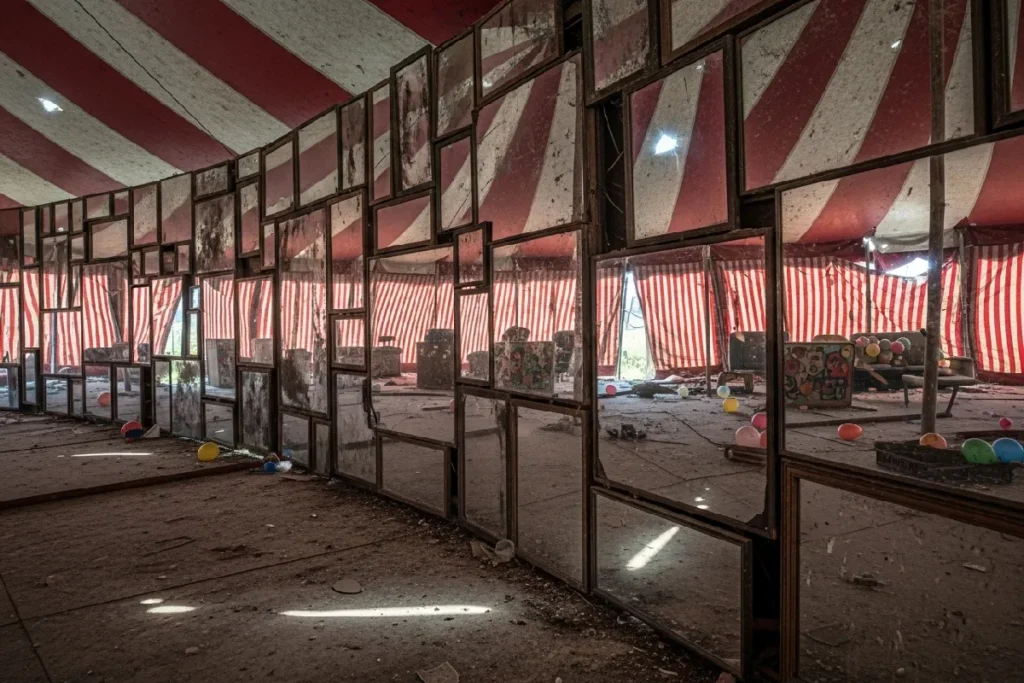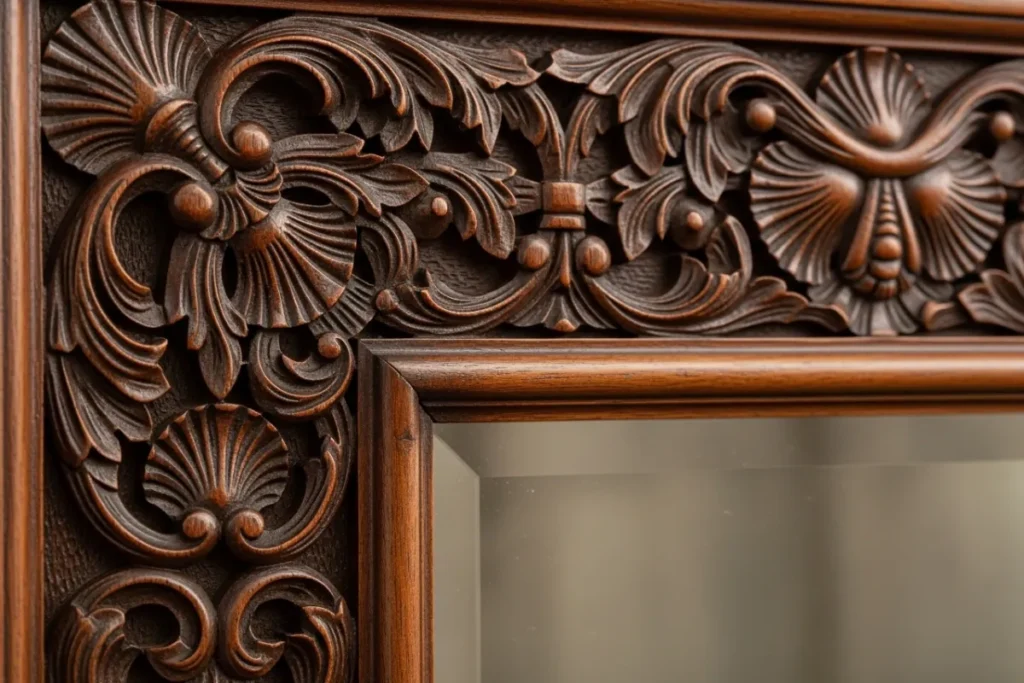Delves into the history of the mirror, revealing how reflective glass shaped self‑perception, superstition, and colonial narratives.
Table of Contents
Introduction: History of the Mirror
The standard history of the mirror is a clean, straightforward tale of technological progress—a simple line drawn from a polished obsidian disc to the flawless silvered glass of a modern bedroom. This narrative is not just boring; it is a deliberate and dangerous lie of omission. It sanitizes the mirror, presenting it as a passive object of vanity when it has always been an active and often violent agent of cultural disruption, psychological manipulation, and imperial power. The true history of the mirror is not one of invention, but of imposition. It is a story written in mercury, blood, and fear.
This article utterly rejects that sanitized timeline. Instead, we will dissect the complete, flawed history of the mirror to expose it for what it truly is: a weapon that helped invent the modern self only to hold it hostage. We will begin before the glass, in the primordial reflections that birthed the terrifying concept of the double. Then, we will move to the toxic workshops of Renaissance Venice, where the “perfect” reflection was used to forge a new, externalized form of identity. This is not just a retelling; it is a reframing of how a simple object remade the human psyche.
Our investigation will then trace the mirror’s path as it became a key instrument of colonial subjugation, a tool for shattering cultural identity with a single glance. We will explore the deep-seated fears it stokes, examining the folklore and horror stories that reveal our anxieties about the fragile self it reflects. Finally, we will bring this dark history into the present, arguing that the smartphone screen is the mirror’s final, most potent form. This is the history of the mirror not as a household item, but as a haunted artifact that has shaped empires, identities, and the very specters in our nightmares.
Before the Glass: The Primordial Reflection and the Birth of the Double
To speak of the history of the mirror is often to speak of Venice and silvered glass, but this is a convenient fiction. The true, far more unsettling history of the mirror begins not with clarity, but with darkness. For millennia, humanity’s reflection was found in the murky depths of a still pond, the distorted sheen of polished bronze in ancient Egypt, or the volcanic glass of an obsidian scrying mirror in Mesoamerica. These were not simple tools for grooming; they were volatile portals. Their reflections were dark, incomplete, and profoundly suggestive, offering not a perfect likeness but a shadowy approximation—a ‘who’ rather than a ‘what.’
This encounter with a primordial double was a defining psychological moment, a foundational event in the human story. For the first time, the self was externalized, transformed into a tangible, silent ‘other’ that stared back. This formative chapter in the history of the mirror is where the object became irrevocably tied to the soul. Was this reflection a captive spirit, a glimpse into the land of the dead, or a doppelgänger lying in wait? The ambiguity of these early reflections birthed a deep-seated metaphysical anxiety that we have never shaken, embedding magic and fear into the very DNA of the looking glass.
Consequently, these first mirrors were instruments of power and divination, not vanity. Their distorted surfaces were read like tea leaves, their shadowy depths used for scrying the future or communing with gods and spirits. The murky, unreliable image was a feature, not a bug, demanding interpretation and reinforcing the authority of the shaman or priest who could decipher its meaning. This supernatural history of the mirror cemented its role as a spiritual technology long before it became a domestic object, establishing a legacy of terror and wonder that even the most flawless modern reflection cannot entirely erase.

The Venetian Monopoly: Silvered Glass and the Invention of the Self
The Renaissance marks a celebrated but toxic chapter in the history of the mirror. On the island of Murano, Venetian artisans perfected the tin-mercury amalgam process, creating glass mirrors of unprecedented size and flawless clarity. This technological leap, however, was built on a jealously guarded, state-enforced monopoly. The methods were a state secret, and craftsmen who attempted to flee with this knowledge were hunted down by assassins. The brilliant reflection that would define an era was born from commercial ruthlessness and the slow poisoning of the workers who handled the toxic mercury, a dark footnote often erased from the triumphant history of the mirror.
This newfound, perfect reflection did not merely coincide with the rise of Renaissance Humanism; it actively fueled it. For the first time, individuals could see themselves with objective clarity, untethered from the allegorical distortion of a bronze disc or the moral judgment of a religious painting. This technological shift enabled the genre of the self-portrait and cultivated a new, radical form of introspection based on the external self. The modern individual, obsessed with their unique appearance and singular identity, was arguably born in the gaze of a Venetian looking glass, making this a pivotal moment in rethinking the history of the mirror as an engine of psychological change.
As a result, mirrors became the ultimate luxury commodity, objects of immense power and desire far more valuable than a country estate or a painting by a master. Kings and queens bankrupted their treasuries to possess them, using these silvered planes to project an image of divine wealth and absolute authority. This phase in the history of the mirror wasn’t just about art or technology; it was about the deliberate commodification of the self. The reflection was no longer a spiritual glimpse but a status symbol, concentrating immense wealth in Venice and transforming the act of looking into an affirmation of one’s place in a rigid social hierarchy.
The Colonial Glare: Mirrors as Instruments of Empire
The consequences of the history of the mirror darken considerably as European ships set sail. The same silvered glass coveted in royal courts was weaponized as a tool of colonial expansion. It became a key instrument in the colonial mirrors trade, a corrupt currency exchanged for vast tracts of land, precious resources, and even human lives. This was not commerce; it was a calculated transaction where a mass-produced novelty was bartered for irreplaceable cultural and material wealth. This cynical chapter in the mirror’s story reveals its role as a lubricant for conquest, greasing the wheels of dispossession.
Colonizers documented the phenomenon of “mirror shock” with a kind of predatory fascination. Indigenous peoples encountering a perfect reflection for the first time often reacted with fear or awe, believing they were seeing a soul or a spirit. But this was not mere anthropological curiosity. European traders and conquerors deliberately exploited this moment, presenting the mirror as proof of their god-like power. The reflection became a theatrical device for asserting technological and spiritual superiority, effectively stunning populations into submission. This manipulation represents a profoundly flawed history of the mirror, one based on psychological warfare.
Ultimately, the mirror functioned as an insidious cultural Trojan Horse. It introduced a fundamentally Western, individualistic way of seeing—one obsessed with the surface self. This new worldview eroded collective identities and supplanted local cosmologies that were often rooted in community, nature, or spirit rather than a singular, reflected image. In this light, we must reframe the history of the mirror not as a passive object of trade but as an active agent of cultural imperialism. It was a silent weapon that imposed a new reality, one reflection at a time.

The Haunted Glass: Reflecting Folklore, Fear, and the Uncanny
Even as technology perfected its surface, the history of the mirror remained inextricably linked with dread. Folklore across the globe bristles with anxieties about its power. The belief that breaking a mirror brings seven years of bad luck speaks to its perceived connection to fate and fortune. The practice of covering mirrors in a house of mourning stems from the fear that a departing soul could become trapped within the glass. And perhaps most famously, the vampire’s lack of reflection signifies a creature without a soul, a being that the mirror—the traditional captor of souls—cannot see. This is the supernatural history of the mirror, a shadow narrative that persists despite centuries of scientific rationalism.
The psychological roots of this terror run deep, stemming from the mirror’s fundamental function: perfect duplication. This act of doubling triggers a profound sense of the uncanny, the Freudian concept of the familiar made disturbingly strange. The face in the glass is ours, yet it is also a silent, unfeeling other—a perfect doppelgänger. This taps into a primal anxiety that our identity is not singular or secure, that a soulless copy could exist and perhaps even replace us. These fears are not irrational superstitions; they are a logical, existential response to the philosophical crisis presented by an object that proves the self can be externalized.
This potent legacy of fear has been endlessly mined by our culture. The haunted looking glass is a cornerstone of Gothic literature and horror cinema, from Edgar Allan Poe’s tales of spectral doubles to modern films like Oculus, where the mirror is an active, malevolent entity. The urban legend of “Bloody Mary” transforms the simple act of looking into a dangerous ritual of summoning. This enduring presence in our scariest stories confirms that the most terrifying part of the history of the mirror is its power to reflect not just our faces, but the inherent instability we fear lies just beneath the surface.
The Digital Reflection: Rethinking the History of the Mirror in the Age of the Selfie
The long history of the mirror has not ended; it has simply migrated. The most influential mirror today is not made of silvered glass but of Gorilla Glass and liquid crystals: the front-facing camera of the smartphone. This pocket-sized black mirror is the direct descendant of the obsidian scrying disc, now connected to a global network. It represents the logical, terrifying endpoint of the mirror’s evolution—a portable, constantly connected device dedicated to the capture, curation, and broadcast of the self. This is not a new chapter; it is the culmination of the entire flawed history of the mirror.
This digital looking glass hyper-intensifies the identity-shaping power we’ve traced. Social media transforms the private act of looking into a relentless public performance. We are no longer just seeing a reflection; we are constructing a digital doppelgänger with filters that sculpt our features and algorithms that validate our existence through likes and shares. The Venetian aristocrat preening before their prized possession pales in comparison to the modern individual curating a self for a global audience. The distortion is no longer a flaw in the glass but a deliberate feature of the software, creating an impossible and marketable ideal.
We are therefore forced to confront the mirror’s ultimate truth. Its primary function was never passive reflection but the active mediation and construction of reality. From the shaman interpreting a murky bronze disc to the influencer choosing the perfect filter, the mirror has always been a tool for creating a desired image, not capturing a real one. In this final, digital phase, the history of the mirror reveals its true purpose. We are no longer simply looking at ourselves; we are projecting an identity into the void and praying for an echo.

Conclusion
We have traced the history of the mirror not as a simple chronicle of innovation, but as a dark lineage of power. Our journey began with the primordial fear of the double, born in the murky sheen of obsidian and still water. We saw how the ruthless commercialism of Renaissance Venice weaponized clarity, forging the modern, externalized self from mercury and glass. We then followed this object across the globe, exposing the colonial mirrors trade for what it was: a calculated tool of psychological subjugation and cultural demolition, leaving a legacy far more fractured than any shattered glass.
The inescapable truth woven through this entire history is that the mirror has never been a passive reflector of reality. It is, and has always been, an active creator of it. It functions as a portal for our deepest anxieties about identity, a canvas for the projection of power, and a conduit for terror, as evidenced by the folklore that haunts its edges. From the king asserting his divine right with a hall of mirrors to the colonizer asserting his superiority with a handheld novelty, the reflection has always been a carefully constructed illusion, serving an agenda.
This flawed history of the mirror offers not a lesson, but a warning for our present age. As we gaze into the black mirror of our devices, curating a digital self for constant judgment, we are participating in this legacy more intimately than ever before. The call to action is therefore a call to consciousness. The next time you seek your reflection, question the image that looks back. Understand that you are not merely seeing yourself, but seeing through an artifact loaded with centuries of power, vanity, and fear. Look closer, and ask who, or what, is truly in control of the glass.








